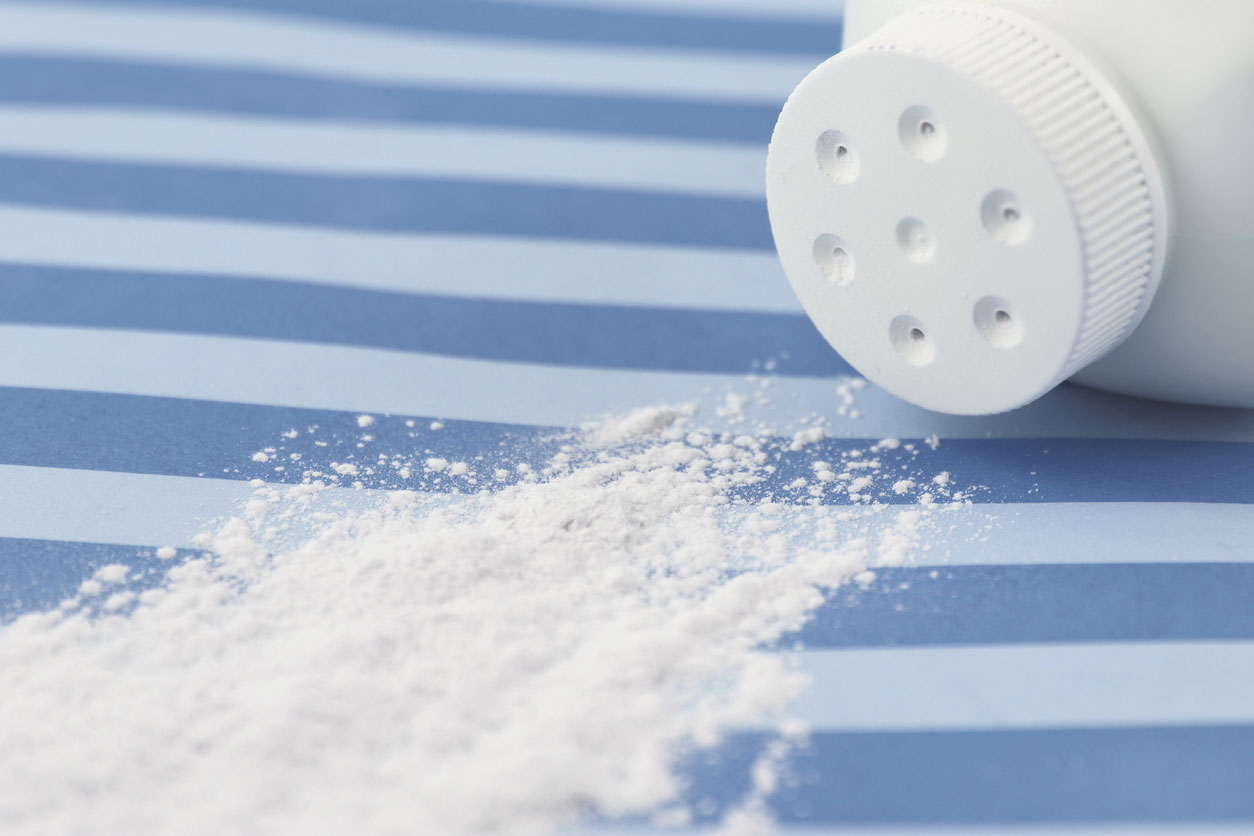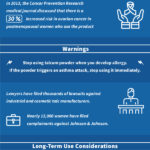A naturally occurring mineral, Talc is composed of magnesium, oxygen, and hydrogen and is known chemically as a “hydrous magnesium silicate”. In its natural form, talc appears as grey/green or white and typically has a somewhat greasy feel to it. However, once it is processed by crushing, drying, and milling, Talc becomes a soft white powder. Given its propensity to absorb moisture, prevent caking, reduce friction or improve the feel of a product, talc has been a popular staple of a range of cosmetic and personal care products on store shelves throughout the United States for years.
Talc is usually mined in proximity to concentrated deposits of asbestos, a known deadly carcinogen. As a consequence, it has been understood for quite some time that, in its natural form, talc will contain asbestos and that exposure to natural asbestos from talc must be limited. Going back as far as 1976, the Cosmetic, Toiletry and Fragrances Association (CFTA), the association representing the cosmetic and personal care products industry, promulgated voluntary standards for its members requiring that all talc used in cosmetic products in the United States should be free of detectable amounts of asbestos.
In addition to concerns about the lung cancer risk from inhalation of asbestos-contaminated talc, concerns have emerged about the potential for ovarian cancer resulting from the application of talc to female genitalia. Over the years, it has been suggested that talc could cause ovarian cancer and many studies have examined the linkage between talcum powder and ovarian cancer. These studies have yielded varying results and the issue has become a singularly contentious topic between health advocates and talcum powder manufacturers who do not believe a linkage exists.
What Products Typically Contain Talc?
- Baby Powder
- Crayons
- Ceramics
- Paint
- Insecticides
- Roofing Materials
- Children’s Toys
- Rubber
- Paper
- Paint
- Polished Rice
- Plastics
- Pharmaceuticals
- Chewing Gum
- Dietary Supplements
- Face Powder
- Mascara
- Lipstick
- Foundation
- Eye Shadow
- Blush
- Children’s Makeup
Talc and Issues with Exposure
Lung Cancer and Mesothelioma
Going back to the 1960s, it has been understood that, even at low levels, asbestos is a potent carcinogen and the cause of lung cancer and mesothelioma. Since that time, the cosmetic industry has gone to great lengths to claim that products which contain talc have “non-detectable” levels of asbestos in them. The term “non-detectable” is a careful choice of words on industry’s part. The U.S. Food and Drug Administration (FDA) itself first raised concerns about the levels of asbestos in talc products in the 1970s and proposed that all cosmetic products needed to be at a minimum 99.9% free of chysotile and amphibole asbestos. However, the CTFA insisted on a lower threshold and as a consequence, most products cannot be labeled “asbestos free”. Hence the industry’s preference for the “non-detectable” standard.
With that in mind, a multitude of studies have failed to draw a direct linkage between ordinary “non-detectable” or “asbestos free” talc containing products and lung cancer. It is only when products that consumers believe or expect are not harmful, turn out to actually contain harmful levels of asbestos, that health concerns arise. In 2019, Johnson & Johnson was prompted to recall 33,000 containers of its iconic baby powder after the FDA found trace levels of chrysotile asbestos. Despite the recall, Johnson & Johnson insisted its baby powder products were safe and questioned whether the FDA tests were accurate. Nonetheless, in 2020, Johnson & Johnson discontinued talc baby powder sales in the Unted States and Canada.
In another case, three cosmetic products marketed to young girls at Justice and Claire’s stores were found to contain trace amounts of asbestos. While Justice recalled its cosmetics, Claire’s did not and the FDA now recommends that the following products be avoided:
- Claire’s Contour Palette – Batch No/Lot No: 04.17
- Claire’s Compact Powder – Batch No/Lot No: 07.15
- Claire’s Eye Shadows – Batch No/Lot No: 08.17
Ovarian Cancer
Physicians, consumer advocates, industry representatives and patients have been aware of a suspected linkage between the sprinkling of talc on female genitalia (“perineal dusting”) and higher rates of ovarian cancer for decades. They also have vehemently different opinions about its existence. Despite the disagreement between these groups as to whether genital talc exposure causes ovarian cancer, a growing body of evidence increasingly suggests a possible connection.
As a predicate, it is important to note that statistically, the rate of ovarian cancer in the general population is around 1%, which is substantially lower than the rate for breast cancer. However, a series of research studies involving large groups of women who have used talcum powder has uncovered that these women are about 30% more likely to be diagnosed with ovarian cancer. Naturally, the world’s largest manufacturer of talc powder, Johnson & Johnson, vehemently disputes these findings and to this day insists that its products are safe.

Warning Labels for Talc Products
Currently, manufacturers of talc products are not required to provide information on their safety. In fact, the FDA has opined recently that it does not believe it has the authority to require any sort of warning on talcum powder marketed in the United States. Consequently, consumers must rely on the manufacturers to provide adequate safety warnings and testing of their products. It is worth noting that in 2018, Health Canada conducted its own research on talc and ovarian cancer and is now considering warning labels among other options.

Legal Developments
In recent years, the world’s largest talcum powder manufacturer, Johnson & Johnson, has been embroiled in litigation with women who claim that their ovarian cancer was caused by the company’s baby powder products. Since 2016, some juries and courts have agreed with them and awarded substantial verdicts and sums for their injuries and loss. The sheer number of lawsuits filed since have caused a substantial number to be combined into multidistrict litigation in federal court in New Jersey (MDL-2738). At the time of this writing, there are in excess of 17,600 cases pending in the MDL.
Sources Cited (16)
1) “FDA: Talc” https://www.fda.gov/cosmetics/cosmetic-ingredients/talc
2) “The Association Between Talc Use and Ovarian Cancer” https://www.ncbi.nlm.nih.gov/pmc/articles/PMC4820665/
3) “Asbestos in commercial cosmetic talcum powder as a cause of mesothelioma in women” https://www.ncbi.nlm.nih.gov/pmc/articles/PMC4164883/
4) “Talcum Powder and Cancer” https://www.cancer.org/cancer/cancer-causes/talcum-powder-and-cancer.html
5) “What Is Talc, Where Is It Used and Why Is Asbestos a Concern?” https://www.nytimes.com/2018/12/14/business/talc-asbestos-powder-facts.html
6) “Asbestos and Talcum Powder: A History of Industry Pushback” https://sum.cuny.edu/asbestos-talcum-history/
8) “Mesothelioma Associated With the Use of Cosmetic Talc” https://pubmed.ncbi.nlm.nih.gov/31609780/
9) “Talc: The Softest Mineral” https://geology.com/minerals/talc.shtml#:~:text=Talc%20is%20a%20mineral%20that,silica%20reacted%20with%20dolomiticmarbles.
10) “Perineal Talc Use and Ovarian Cancer: A Critical Review” https://www.ncbi.nlm.nih.gov/pmc/articles/PMC3621109/
11) “Pulmonary talcosis 10 years after brief teenage exposure to cosmetic talcum powder” https://www.ncbi.nlm.nih.gov/pmc/articles/PMC3185388/
12) “Douching, Talc Use, and Risk of Ovarian Cancer” https://www.ncbi.nlm.nih.gov/pmc/articles/PMC5141580/
13) “Johnson & Johnson discontinues talc-based baby powder in US and Canada” https://www.cnbc.com/2020/05/19/johnson-johnson-discontinues-talc-based-baby-powder-in-us-and-canada.html
14) “FDA Advises Consumers to Stop Using Certain Cosmetic Products” https://www.fda.gov/cosmetics/cosmetics-recalls-alerts/fda-advises-consumers-stop-using-certain-cosmetic-products
15) “Talcum Powder and Ovarian Cancer” http://www.center4research.org/talcum-powder-ovarian-cancer/
16) “FDA bowed to industry for decades as alarms were sounded over talc” https://www.reuters.com/investigates/special-report/usa-health-fda-talc/



